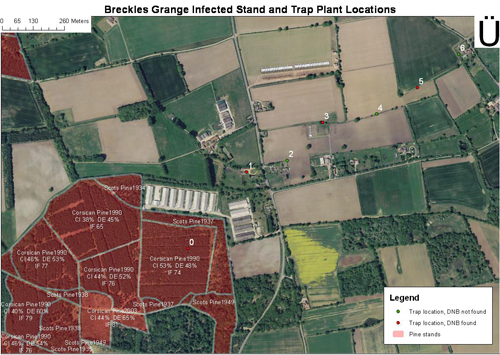Summary
The distance the spores of the pathogen are able to travel under natural conditions in Britain is unknown and the aim of this work was to understand more about this process.
Research objectives
- Establish a reliable method for detecting infected needles of pine in the early stages of disease development.
- Determine the distance DNB is able to spread under natural conditions in Britain using ‘trap plants’ placed at known distances from sources of infection to intercept spores of the pathogen.
Results
A realtime PCR method has been tested and refined to detect and quantify D. septosporum in infected pine needles. Using this and visual symptoms of infection, we found the disease could be detected at far greater distances from inoculum sources than previous work of this type has shown. We also found the spread of the disease does not decline steadily with distance from the inoculum source but spreads more irregularly, probably reflecting changing wind patterns and air turbulence.
Read the article with project results

Status
Work on the local spread of D. septosporum began in September 2010 and is now completed.
Related Services
To report a finding of Dothistroma to Forest Research scientists please use TreeAlert
Related Resources
Dothistroma needle blight FC webpage
Dothistroma needle blight Questions and Answers
Background
The disease of pines, Dothistroma needle blight (DNB), is caused by the fungus Dothistroma septosporum, which is widespread in Britain. In order to limit the spread and damage of DNB, planting stock must be produced that is free of the disease and nurseries that produce this stock are inspected for any signs of disease and affected plants destroyed. Therefore, production nurseries must be located away from infected forest stands which can generate large amounts of inoculum and potentially result in the production of infected seedlings.
Contact
Funders and Partners
Funded as part of the Forestry Commission Advice and Scientific Support for Tree Health Programme
Forestry Commission policy
This research underpins the evidence base for the delivery of healthy and resilient forests and wider ecosystems which is part of the Tree Health and Plant Biosecurity Action Plan
